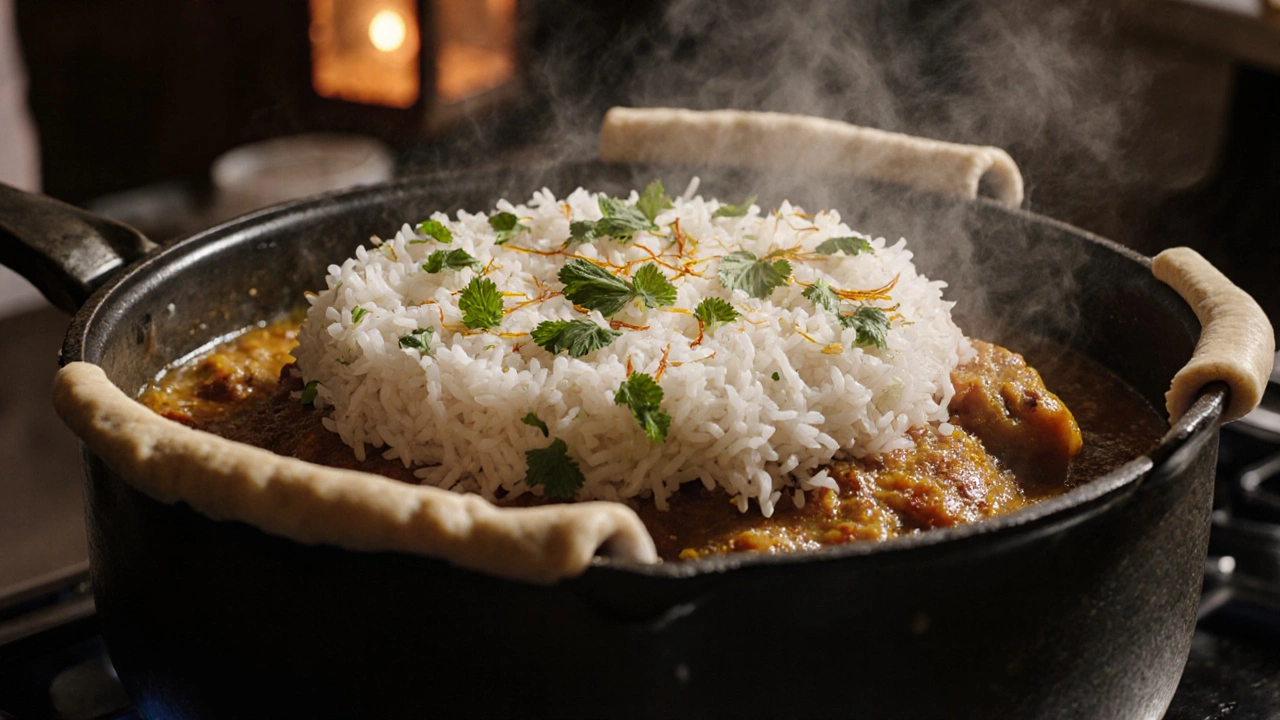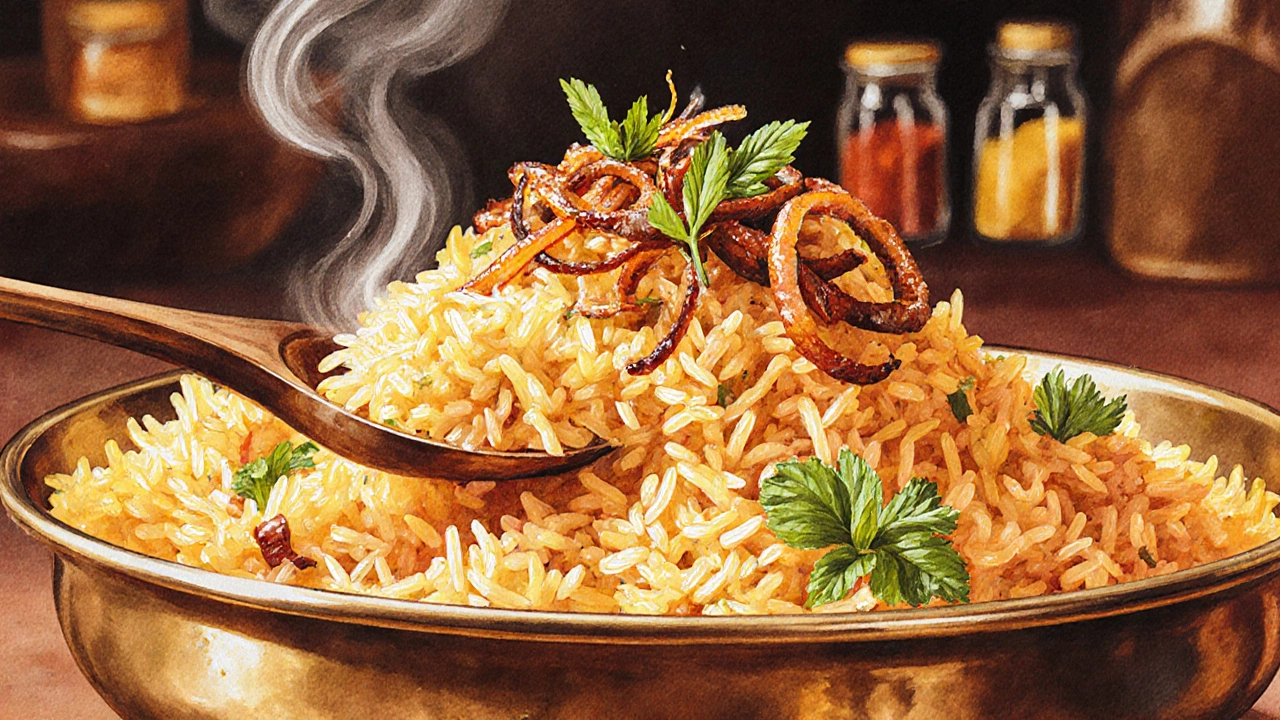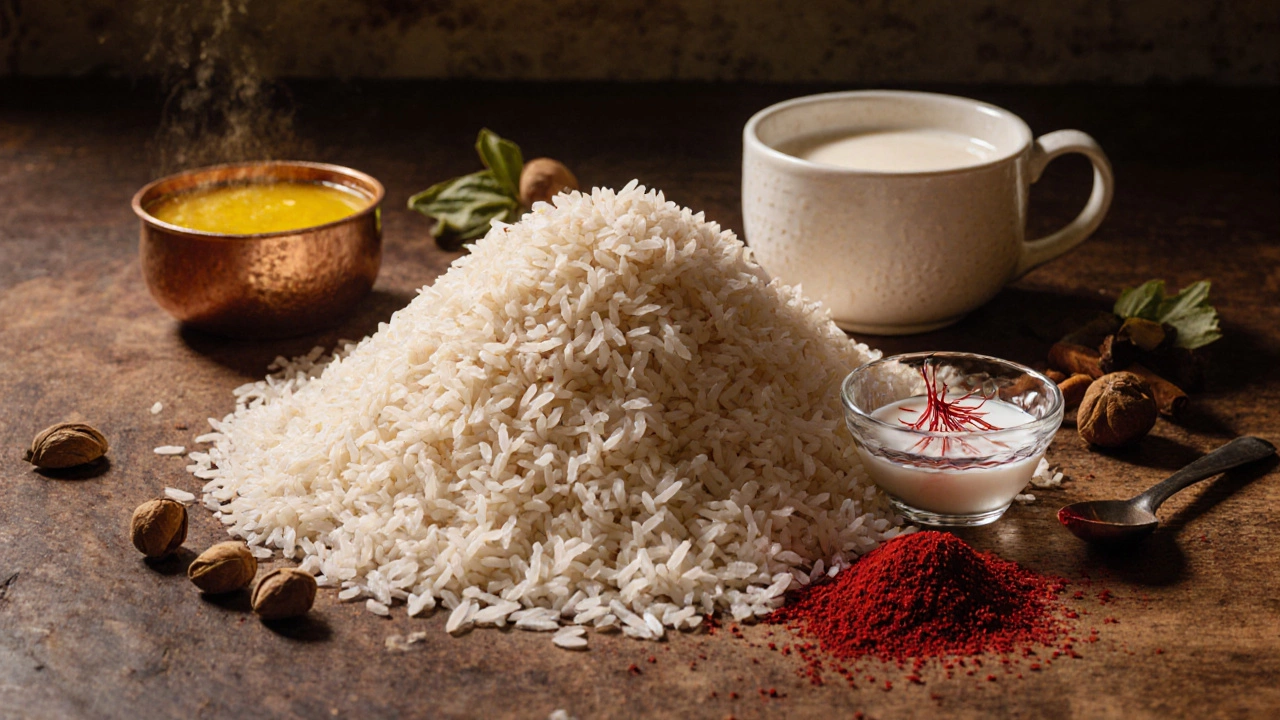Biryani Ingredient Calculator
Perfect Biryani Starts with Precise Measurements
Use this calculator to determine the exact ingredient amounts for your biryani based on the number of servings. Follow the article's recommendations for optimal results.
Calculated Ingredients
Enter servings and click "Calculate Ingredients" to see your recipe.
Pro Tip: Always use long-grain Basmati rice for authentic texture. For 4 servings, you'll need approximately 400g rice, 30ml ghee, 0.2g saffron, 2 tsp garam masala, and 200ml yogurt.
Key Takeaways
- Long‑grain Basmati rice provides the fragrant backbone that defines biryani.
- Ghee adds richness and helps the rice grains stay separate.
- Saffron and garam masala create the signature aroma and color.
- Yogurt in the meat‑marinade keeps protein juicy and supports the dum‑cook.
- Layering and sealed‑pot cooking (dum) lock in flavor - the final step that makes everything work together.
When you ask yourself, "What is the most important ingredient in biryani?" the answer isn’t a single magic spice. It’s a combination of a few core elements that each solve a specific cooking problem. Skip any one of them, and the dish loses its signature texture, aroma, or depth. Below we break down each pillar, explain why it matters, and give practical tips you can apply tonight.
Biryani is a layered rice‑and‑meat dish that originated in the Indian sub‑continent. It relies on precise timing, aromatic spices, and a delicate balance of moisture and heat to achieve its celebrated flavor profile.
The Grain That Holds It All Together: Basmati Rice
Basmati rice is a long‑grain variety known for its nutty fragrance and fluffy texture when cooked correctly. Its slender grains stay separate after the dum‑cook, creating the airy mouthfeel that distinguishes biryani from a simple pilaf. If you substitute a short‑grain rice, the layers will clump, and the dish will feel heavy.
- Rinse the rice three times until the water runs clear - this removes excess starch.
- Soak for at least 30 minutes; soaked grains absorb water evenly, reducing cooking time.
- Par‑boil with a pinch of salt and a couple of whole spices (cardamom, bay leaf). The grains should be about 70% cooked before layering.
Why does this matter? The partially cooked grain continues to steam gently under the sealed lid, finishing its job without turning mushy. The result is distinct, fragrant grains that can be lifted with a fork.
Richness and Separation: The Role of Ghee
Ghee is clarified butter that carries a nutty flavor and a high smoke point. In biryani, ghee performs three jobs:
- Flavor base: Sautéed onions, garlic, and spices absorb ghee’s buttery richness.
- Grain separation: A thin coating of ghee on each rice layer prevents the grains from sticking together.
- Heat conductor: Its high smoke point allows you to brown meat without burning.
Tip: Use about 2‑3tablespoons of ghee for a 4‑person biryani. If you’re watching calories, you can replace half with a neutral oil, but you’ll lose some of the signature aroma.

Aromatic Powerhouses: Saffron and Garam Masala
Saffron is the world’s most expensive spice, harvested from the stigmas of Crocus sativus. A few strands steeped in warm milk give biryani its golden hue and a subtle floral note that brightens the whole pot.
Meanwhile, Garam masala is a blend of roasted spices (cinnamon, cloves, cardamom, cumin, coriander, pepper). Adding it toward the end of cooking preserves its volatile oils, delivering a warm, lingering finish.
- Steep 0.2grams of saffron in 2tablespoons of warm milk for 10minutes.
- Sprinkle the saffron milk over the final rice layer just before sealing the pot.
- Mix 1‑2teaspoons of garam masala into the meat‑marinade or sprinkle over the top before the dum.
These two ingredients are the aromatic signature; without them, the dish tastes flat, no matter how perfect the rice or meat.
Moisture, Tenderness, and the Secret of Yogurt
Yogurt is an acidic dairy product that softens protein fibers and adds a tangy depth. When you marinate chicken, lamb, or goat in yogurt mixed with spices, the acid gently breaks down muscle fibers, resulting in juicy meat that stays tender during the long dum‑cook.
Typical marination ratio: 200ml plain yogurt per kilogram of meat, plus ginger‑garlic paste, chili powder, and a pinch of salt. Marinate for at least 2hours, preferably overnight.
Layering and the Dum Technique: The Final Glue
The most important biryani ingredient is actually the cooking method itself - the sealed‑pot “dum” process. By trapping steam, you let the flavors meld while the rice finishes cooking gently.
Steps:
- Spread a layer of partially cooked rice over the simmering meat.
- Top with fried onions, fresh herbs (mint, coriander), and the saffron milk.
- Cover the pot with a tight‑fitting lid. Seal the edges with dough or foil to prevent steam escape.
- Place a heavy skillet or a thick trivet on the lid and reduce heat to low. Cook for 20‑30minutes.
Result: The steam infuses the rice with the meat’s juices, while the layered aromatics release their oils upward, creating a fragrant, unified dish.

Common Pitfalls & Pro Tips
- Over‑cooking the rice: If the grains are fully cooked before layering, they will turn mushy during dum. Always aim for 70% doneness.
- Insufficient sealing: Any steam leak drops the temperature, causing uneven cooking. Use dough or aluminum foil to create a hermetic seal.
- Too much liquid: The marinated meat already releases juices. Add extra water only if the rice appears dry after the first 10minutes of dum.
- Skipping fried onions: Crisp, golden onions add sweetness and texture. Fry thin slices until deep amber; reserve half for garnish.
Quick Ingredient Comparison
| Ingredient | Primary Role | Typical Quantity (per 4 servings) | Cost Impact |
|---|---|---|---|
| Basmati rice | Base grain, fragrance | 400g | Medium |
| Ghee | Richness, grain separation | 30ml | Medium‑High |
| Saffron | Color, floral aroma | 0.2g (≈5 strands) | High |
| Garam masala | Warm spice finish | 2tsp | Low |
| Yogurt | Meat tenderizer, moisture | 200ml | Low |
Mini FAQ
Can I use regular white rice instead of Basmati?
You can, but the rice will be stickier and lack the signature fragrance. If you must, rinse thoroughly and add a pinch of rose water or extra saffron to compensate for flavor.
Is ghee essential, or can I use oil?
Ghee gives the classic buttery aroma and helps keep rice grains separate. Replacing it with oil will work for texture but you’ll miss the distinctive taste.
How long should I seal the pot for the dum cook?
Typically 20‑30minutes on low heat. If you’re using a heavy‑bottomed pot, 25minutes is a safe bet. Avoid high heat; it will evaporate steam too quickly.
Can I make a vegetarian biryani with the same principles?
Absolutely. Replace meat with paneer, mixed vegetables, or boiled potatoes. Still marinate in yogurt and keep the same spice blend to retain depth.
What’s the best way to store leftovers?
Cool the biryani quickly, then store in an airtight container in the fridge for up to 3days. Reheat gently on the stovetop with a splash of water to revive the steam.
